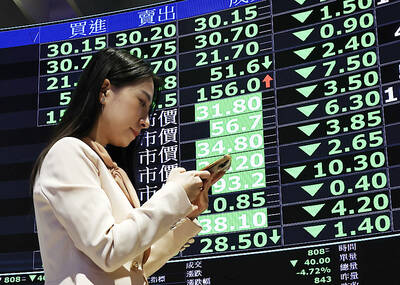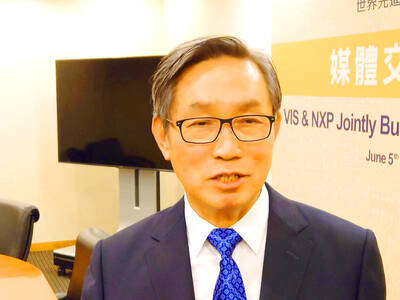Mio Technology Ltd (
The company has been enjoying strong momentum in recent years, with worldwide shipments this year expected to more than double to 3.5 million units, Samuel Wang, president of Mio Technology, told reporters yesterday.
Last year's shipments totaled 1.6 million units, nearly twice the 900,000 units in 2005, according to company statistics.
"Driven by sales in the US and Europe, we will see rosy prospects this year," Wang said.
Mio Technology only moved into the competitive US market at the end of last year, yet has already managed to gain a 6 percent market share, Wang said, adding that it aimed to boost share to 11 percent at around 700,000 units this year.
In Eastern Europe, which is the company's major market, sales are expected to rise to 1.7 million units from 0.9 million last year, he said.
If the shipment target is met, Wang said that the company was confident it would post NT$30 billion (US$913.3 million) in sales for this year -- up from NT$13 billion last year.
According to researcher Gartner Inc, Mio Technology ranked fifth in worldwide personal digital assistant (PDA) shipments in the third quarter last year.
Shipments grew 86 percent from one year ago because of high demand for PDAs that feature GPS navigation capabilities.
Mio Technology announced yesterday that it would launch a new service next month that offered real-time information on weather, parking space availability and traffic conditions to local users for free.
Mio Technology is the marketing arm of MiTAC International Corp (
MiTAC branched out into the high-margin GPS-device market in November 2003
with the Mio brand.
MiTAC, which also produces desktop computers, motherboards and servers, is
expected to churn out a total of 7 million GPS devices this year, up from
last year's 4.5 million, according to Wang.
There is no plan to separate its own brand business from contract
production, as clients are not concerned about a differentiation as long as
MiTAC continues to offer them competitive production and pricings, he said.
MiTAC shares closed down 1.2 percent to NT$40.75 on the Taiwan Stock
Exchange yesterday.

TARIFFS: The global ‘panic atmosphere remains strong,’ and foreign investors have continued to sell their holdings since the start of the year, the Ministry of Finance said The government yesterday authorized the activation of its NT$500 billion (US$15.15 billion) National Stabilization Fund (NSF) to prop up the local stock market after two days of sharp falls in reaction to US President Donald Trump’s new import tariffs. The Ministry of Finance said in a statement after the market close that the steering committee of the fund had been given the go-ahead to intervene in the market to bolster Taiwanese shares in a time of crisis. The fund has been authorized to use its assets “to carry out market stabilization tasks as appropriate to maintain the stability of Taiwan’s

STEEP DECLINE: Yesterday’s drop was the third-steepest in its history, the steepest being Monday’s drop in the wake of the tariff announcement on Wednesday last week Taiwanese stocks continued their heavy sell-off yesterday, as concerns over US tariffs and unwinding of leveraged bets weighed on the market. The benchmark TAIEX plunged 1,068.19 points, or 5.79 percent, to 17,391.76, notching the biggest drop among Asian peers as it hit a 15-month low. The decline came even after the government on late Tuesday authorized the NT$500 billion (US$15.2 billion) National Stabilization Fund (國安基金) to step in to buoy the market amid investors’ worries over tariffs imposed by US President Donald Trump. Yesterday’s decline was the third-steepest in its history, trailing only the declines of 2,065.87 points on Monday and

TARIFF CONCERNS: The chipmaker cited global uncertainty from US tariffs and a weakening economic outlook, but said its Singapore expansion remains on track Vanguard International Semiconductor Corp (世界先進), a foundry service provider specializing in producing power management and display driver chips, yesterday withdrew its full-year revenue projection of moderate growth for this year, as escalating US tariff tensions raised uncertainty and concern about a potential economic recession. The Hsinchu-based chipmaker in February said revenues this year would grow mildly from last year based on improving supply chain inventory levels and market demand. At the time, it also anticipated gradual quarter revenue growth. However, the US’ sweeping tariff policy has upended the industry’s supply chains and weakened economic prospects for the world economy, it said. “Now

An employment discrimination lawsuit against contract chipmaker Taiwan Semiconductor Manufacturing Co (TSMC, 台積電) might soon be expanded after a hearing in a federal court in San Jose, California, on Tuesday to add 15 plaintiffs to the case. According to a court document, the lawsuit, which was refiled in November last year as a form of a class action with 13 plaintiffs in California, wants to add 15 plaintiffs from Arizona, where TSMC is building up its wafer fab capacity. TSMC first committed between 2020 and last year to invest US$65 billion in three advanced wafer fabs in Arizona. It then pledged an